Unpacking The Legend Of Vincent Motorcycles
England, United Kingdom
Delving into why the most expensive bike in the world, is the most expensive bike in the world.
As of today, Vincent Motorcycles are the most valuable bikes on the planet. But what is it about them that makes them so special? So exorbitant? Well, it helps to know a little about the history of the iconic brand to fully grasp its impact on the course of motorcycling.

The Legend Of Vincent Motorcycles
The History Of A Legend
Howard Raymond Davies was a British fighter pilot who was shot down in WW1 and sent to a German POW camp. It was while in captivity he conjured up the idea of designing and building his own production motorcycle. After the war, Davies returned to his native UK where he and one E.J. Massey together founded HRD Motorcycles in 1924. Around this same time board-track racing was reaching its peak in popularity, and motorcycles were evolving from bicycles fitted with motors to refined, increasingly purpose-built machines.
Despite having some success in competition, HRD was unable to make ends meet and in early 1928 closed its doors for good. A young kid named Phillip Conrad Vincent was able to purchase the recently defunct company along with all of its tooling and machine equipment for a reported sum of £450. Phil — who’s family operated a lucrative Argentine cattle operation — was bit by the riding bug only a few years prior at the age of 16 when he got his first bike, a 350cc Beezer (BSA). The new owner and company namesake moved the operation to Stevenage, set up shop, and started producing the first Vincent Motorcycles — though they still bore the HRD name, albeit with the words “Vincent” scribbled underneath in small lettering.
Vincent’s first bikes used engines from established outfits like JAP and Rudge-Python, but in 1931 Vincent brought on Phil Irving, a seasoned race engineer, to design a completely new Vincent engine from the ground up. Irving first delivered a half-liter OHV single that generated around 26hp at 5,300rpm. The design was improved over the next couple years, until 1936, when the first “true Vincent” arrived.
Birth Of The Vincent V-Twin
As the story goes, Irving was at his desk, looking over some tracings of the 500cc thumper when he happened to overlay two pages. He moved the tracings on top of each other, tilting the tops outward and joining the images at the bottom in a 47.5-degree V-shape (see where this is going?). That inadvertent event gave way to one of the most legendary motorcycles of all time. Irving refined the idea, and eventually combined the two half-liter thumpers on paper into a single case, creating the first Vincent V-Twin.
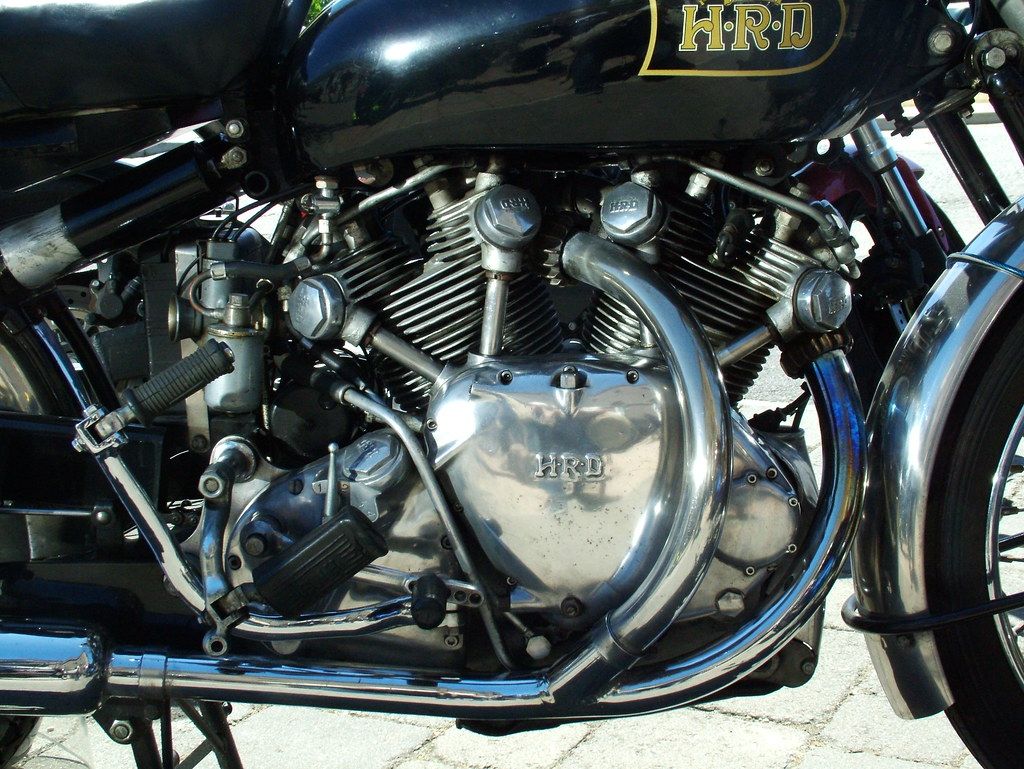
The 50-degree twin-cylinder heart of the legendary Vincent
The engine was dropped into, what at the time was, an incredibly sophisticated brazed lug frame, with the model being dubbed, the Series A Rapide, which was capable of doing 110mph right out of the box. The Rapide sported Phil Vincent’s patented cantilever rear suspension (think primitive monoshock) and a girder fork out front. The model was far from cheap, but owning the world’s fastest production motorcycle never is.
World War 2
When WW2 rolled around it threw a spanner in the works for the brand, which pivoted and starting producing an array of non-motorcycle-related goods, though after the war things took off even more for the Steveage firm. Post WW2 Vincent started getting a lot of business from the US, so in 1949 it was decided that the HRD part of the name would be dropped from the moniker, as Vincent worried it was too similar to the well-known H-D brand.
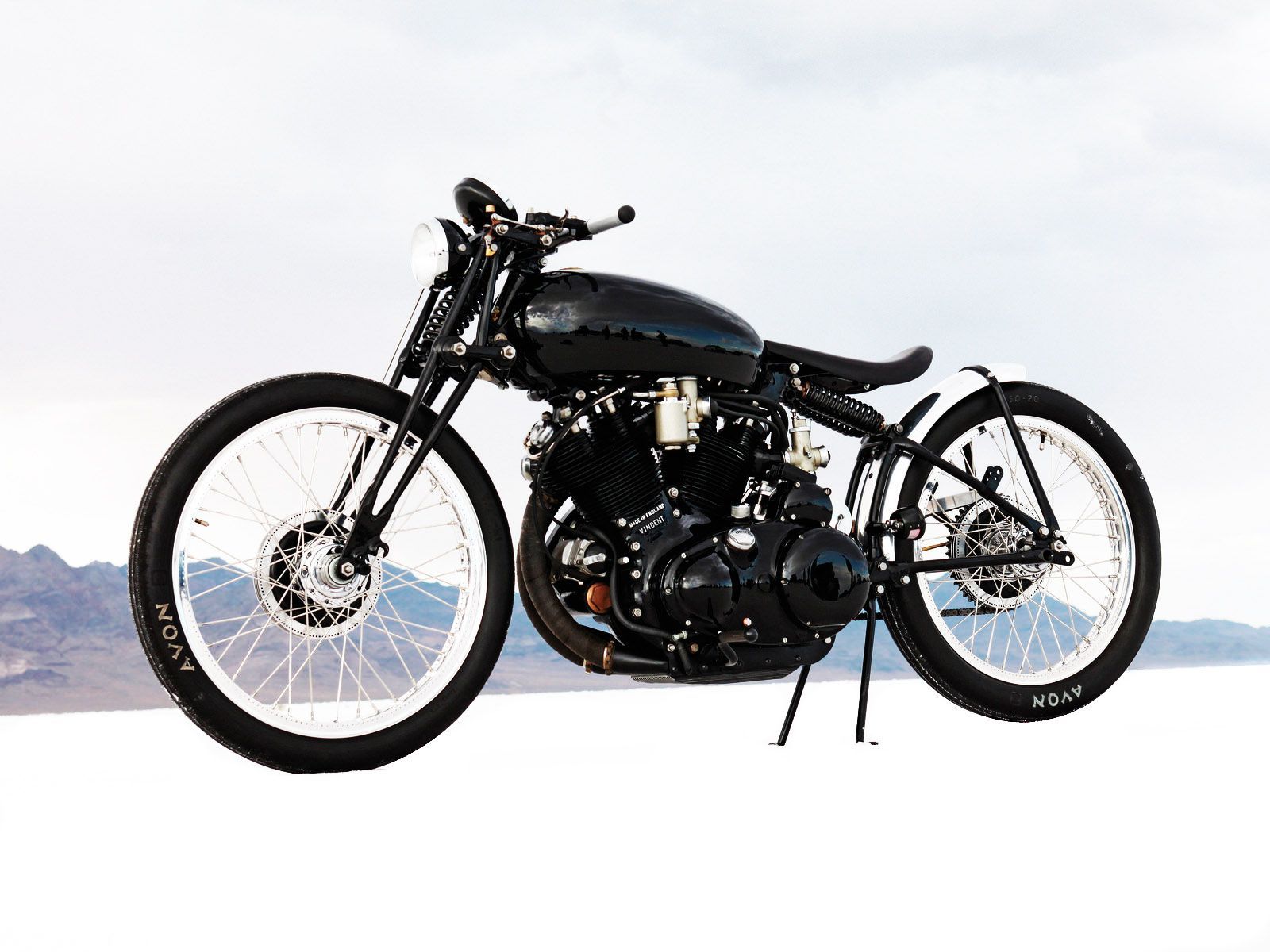
1952 Vincent Black Shadow; one of the later Vincent racers
It’s worth noting that the post-war market in Europe was primarily comprised of outfits churning out small displacement, economical offerings. Vincent’s vision didn’t include much of any compromise — a trait that would later bring down the company — and while brands like Moto Guzzi and MV Agusta we’re building their names off these affordable little runners, Vincent took things in the opposite direction and was building cutting-edge, high-performance, big-bore bikes that came with considerable price tags.
Thanks to another decade of development, Irving was able to make a suite of major improvements to the Series A. This included a unit-construction engine that was utilized as a stressed member of the chassis — which also internally housed the oil-lines. The rear suspension design was improved, as were the brakes, a new reversible quick-detach rear-wheel was introduced (with different gearing on either side), and the angle of the V went from 47.5-degrees to an even 50.
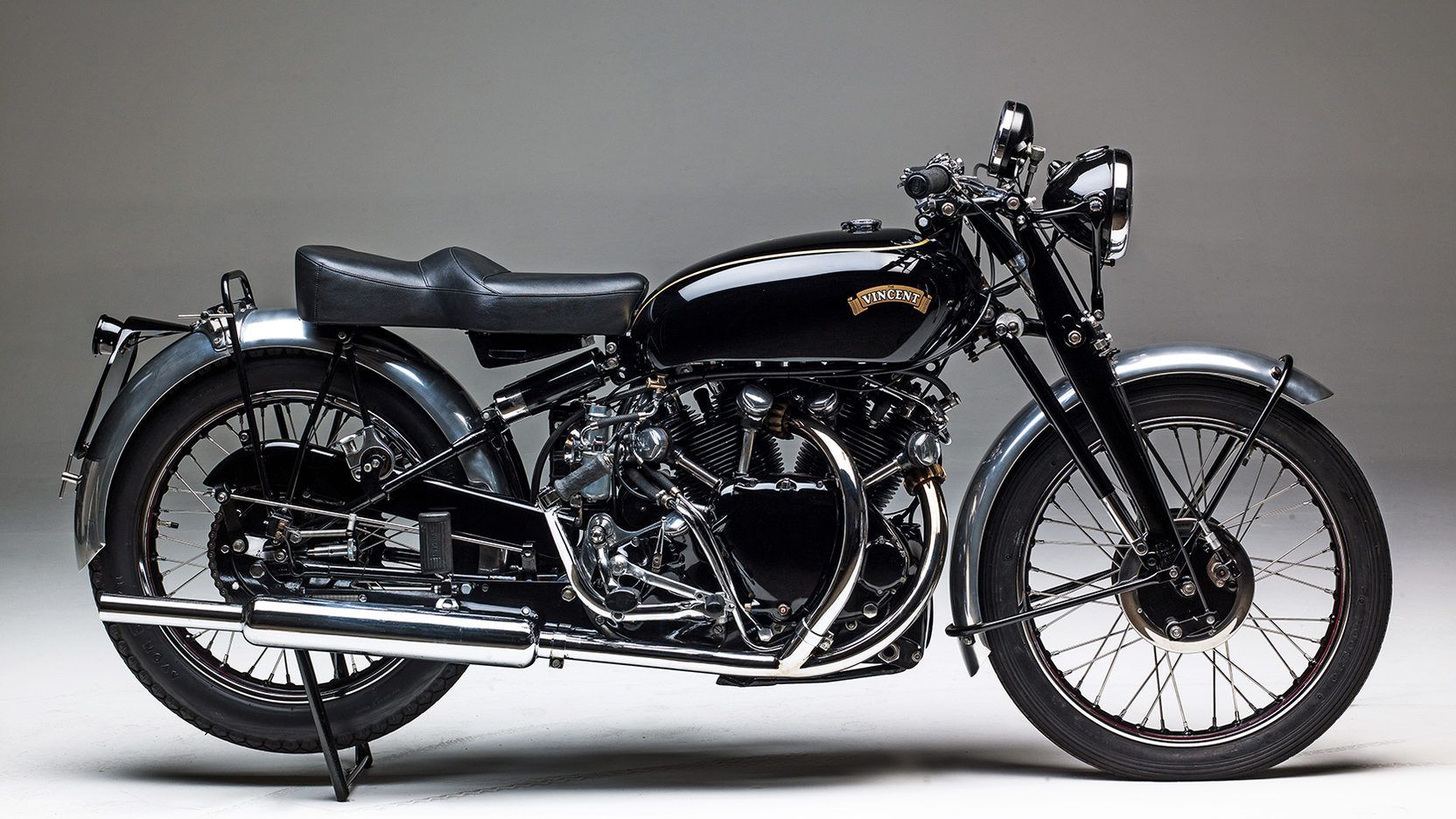
1948 Vincent Series B Rapide
Refining A Record-Breaker
These changes amounted to the Series B, though over the next decade or so Vincent went on to release the Series C, and Series D. They all used what was essentially the same base twin engine, albeit the later models were obviously more refined. Later on race versions of the original models were produced, which started achieving world-records all over the damn place. One year a record would be set on a Vincent, only to have it beaten the following year by a rider piloting (you guessed it), another Vincent.
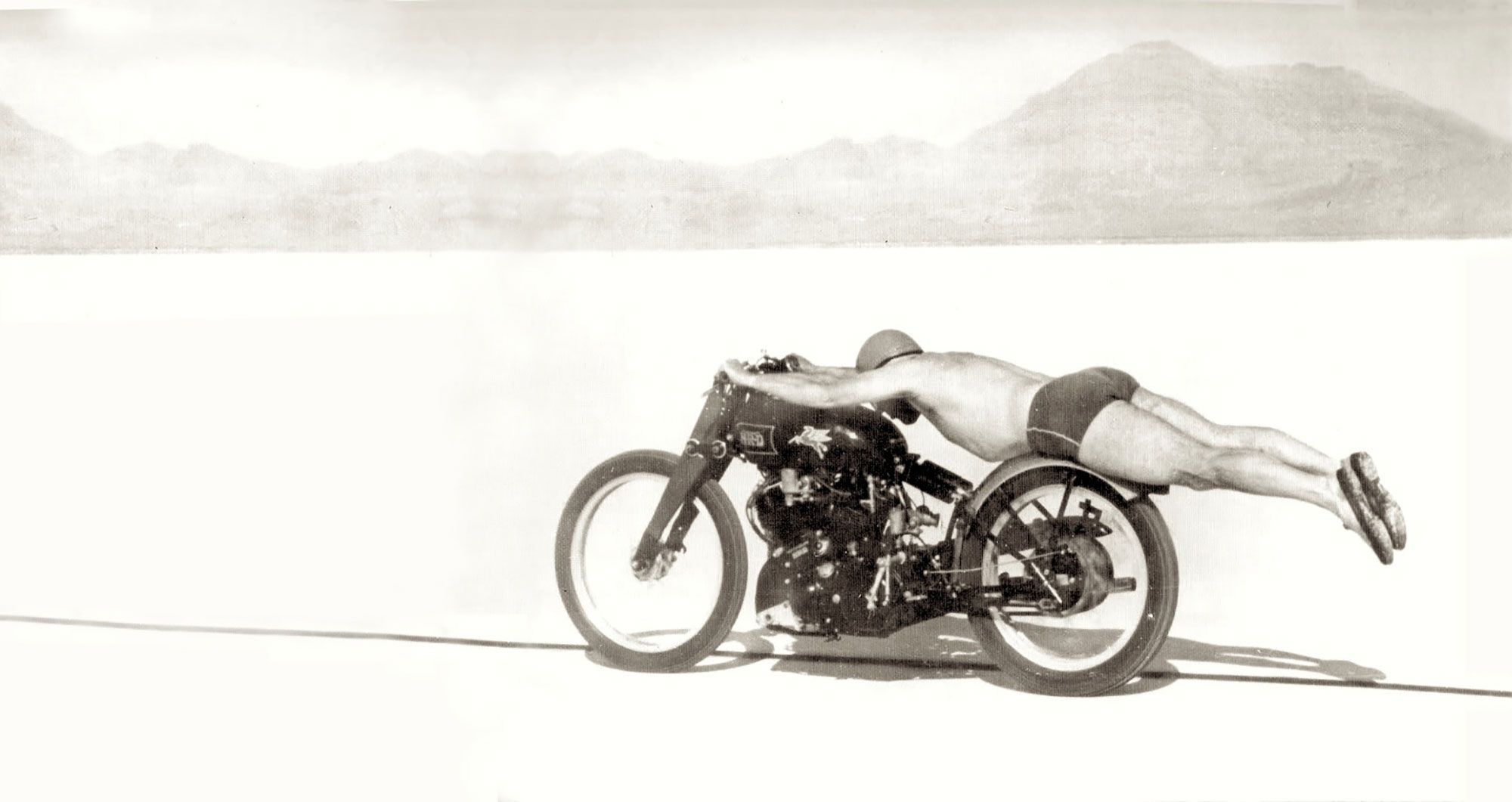
The most famous record set on a VIncent was probably the one seen here achieved by Rollie Free
Big Name, Small Production Output
Unlike most renowned motorcycle companies, Vincent produced very, very few units in its 28-year-history. By 1946, Vincent was in full swing and was still only producing around 1,100 motorcycles per year — a trend that remained under it shut down. As a point of reference, Triumph at its peak was producing some 30,000 Bonneville models per month, and the Bonnie was just one of several models offered by the iconic British marque. Triumph’s bikes also cost literally half of what Vincent’s did too.
All Good Things Must Come To An End...
Though Vincent had successfully predicted future trends in motorcycling in the past, the company’s founder became convinced that the public wanted fully enclosed engines and ample protection from the elements in the form of some bulbous and wonky bodywork. So the Rapide was given a full fairing and sold as the Black Knight while the enclosed-version of the Black Shadow was dubbed the Black Prince. The models were a bust and as a result, the firm took a major financial hit.

The Vincent Black Knight (right) and Black Prince (left)
Because the company was already churning out bikes in such small numbers, scaling back production wasn’t an option. By the mid-1950s it was clear that the Vincent brand was on thin ice, so advisors began urging Phillip to look for areas to save money. Phillip staunchly refused to reduce the quality of his machines and in 1955 Vincent Motorcycles went under. Though production ceased, Vincent continued offering parts for its bikes for decades — as the founder had promised upon closing. Believe it or not, you can still source Vincent parts even today (for a steep price) though the relatively tiny number of surviving examples means the low demand has prevented scarcity, even after more than half-a-century.
Recognizing Motorcycling Greatness
To say that Vincent motorcycles were ahead of their time is an understatement. The things made over 70hp in the post-war era and were capable of getting well into the triple-digits. They boasted advanced components such as a monoshock, trick materials like magnesium alloy, and were shockingly reliable for their levels of performance — unlike many of the race-oriented offerings coming from Italy at this time. For years Vincent held the title of “fastest production motorcycle in the world”. Even after a decade had passed since Vincent shut down, it still held that honor — a fact that speaks volumes about how advanced these machines were.

This is what the world's most expensive looks like.
Though Vincent motorcycles weren’t ever considered inexpensive, it's still hard to wrap one’s head around just how much they’re worth today. Because of the brand’s prestige and race pedigree, compounded by how few units were produced, Vincent motorcycles have become the most valuable motorized two-wheelers in existence. Surviving specimens routinely sell for absurd amounts, and even basket-case examples will routinely fetch six-figures. On January 26, 2018, a 1951 Vincent Black Lightning that had previously set multiple speed records in Australia, went on to set one more record; the world’s most expensive bike ever sold, when it crossed Bonham’s Las Vegas Auction block and fetched $929,000 (not including any fees).
It's now been almost six--and-a-half-decades since Vincent closed its doors, but the spirit of the famed marque still very much lives on today. Vincent's drive to constantly push the envelope of innovation and the ability to reshape the motorcycling world's perception of what was possible has left an indelible mark on the sport, forever altering the two-wheeled timeline and continuing to inspire engineers to this day. In under 30-years, Vincent Motorcycles became a legend.
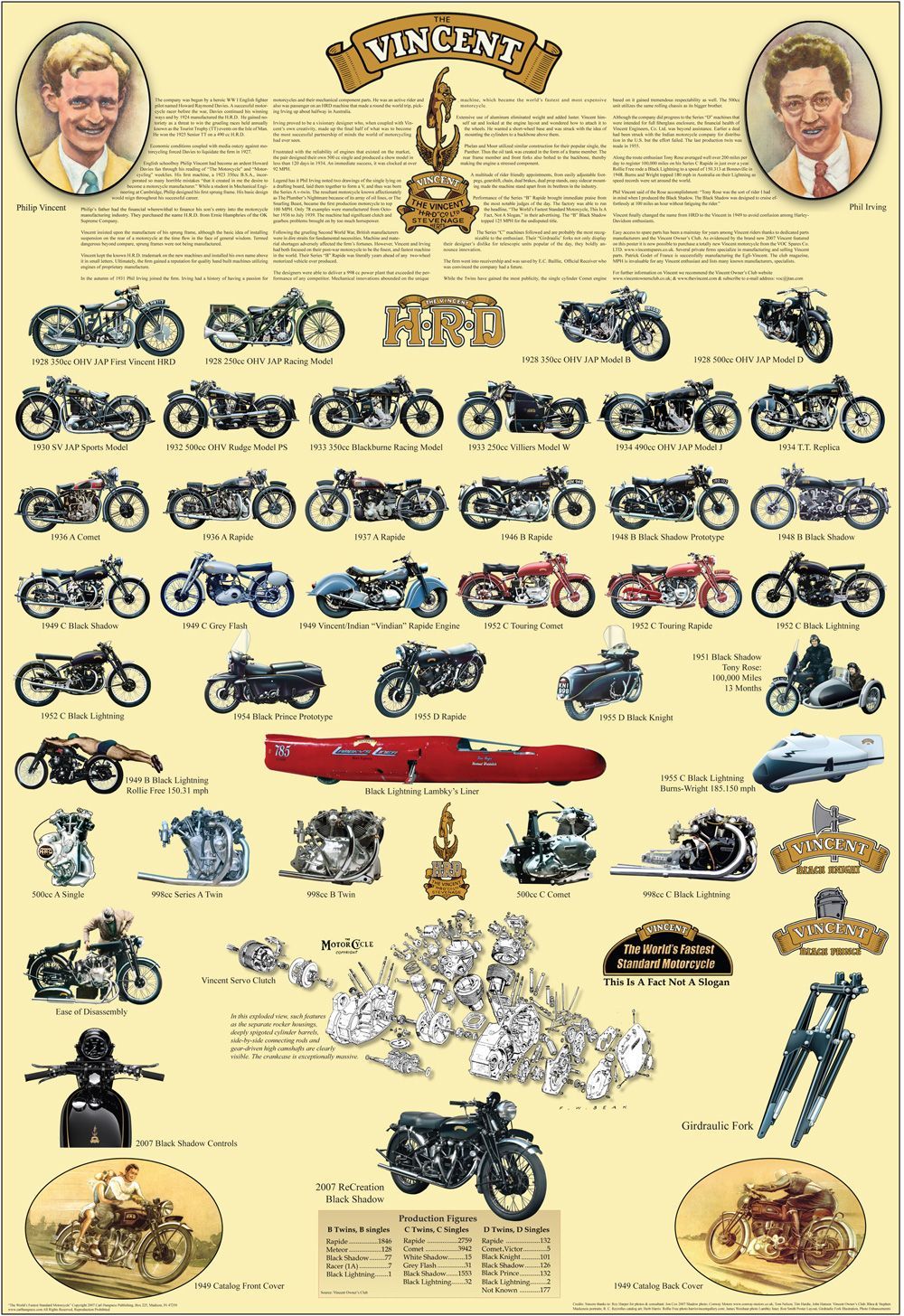
A fun diagram of the many offerings from the Stevenage firm
You must be logged in to comment
Login now
Oops. The photograph captioned a Series B Rapide is actually a Series C Black Shadow...